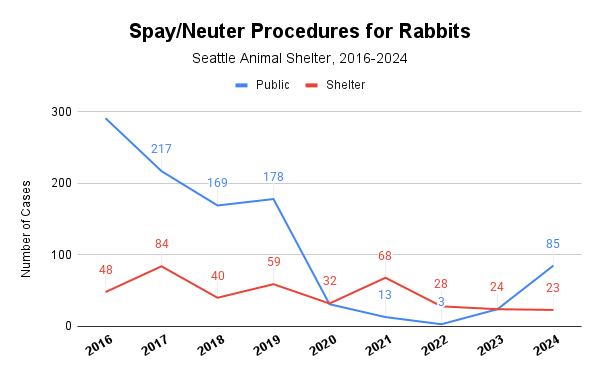Seattle Animal Shelter Spay/Neuter Procedures 2024 Update
- seattleanimalwatch
- Jun 20
- 3 min read
Public and Shelter Procedures Rebound From 2023
Community Cat Procedures Crater
The Seattle Municipal Code established a spay/neuter clinic (the Clinic) for the public in 1978 via an initiative approved by the voters. The Seattle Animal Shelter’s veterinary staff currently administers this program under the management of the shelter director. The clinic is meant to provide a public service, as well as to spay and neuter shelter animals.
The Seattle Animal Shelter’s spay/neuter services suffered post-COVID due to staffing shortages. However, spay/neuters for both owned and shelter animals almost doubled in 2024 thanks to a (finally) fully-staffed veterinary team. The exception is community cat procedures which dropped over 80 percent from 2023 to 2024.
There is a clear need for low-cost spay/neuter services in Seattle based on Seattle Animal Shelter data alone. However, space and staff limitations do not allow for a clear picture of how great that need is. We can only determine the actual scope by collecting data and expanding analysis to those organizations who have had to absorb the overflow of those for whom SAS did not have availability.
Spay/Neuter Clinic Almost Doubles Surgeries in 2024
The results of a fully-staffed veterinary team is evident in the sharp increase in surgeries from 2023. Surgeries, including those outside of spay/neuter, increased by almost 90 percent, from 1,310 in 2023 to 2,471 in 2024. This is welcome news.

Spay/Neuter Services, Public vs. In-Shelter
When we isolate actual spay/neuter procedures, SAS data also shows a significant increase in procedures. There was an increase in shelter animal procedures from 900 in 2023 to 1,134 in 2024, or a 26 percent increase. Spay/neuters of animals owned by the public more than doubled from 410 procedures in 2023 to 1,116 in 2024. Not only does this clearly reflect the value of a fully staffed medical team at the shelter, but it also reflects the clear need the public has for low-cost spay/neuter services.

Spay/Neuter Services by Species
There are three primary species that receive SAS spay/neuter services: canines, felines, and rabbits. (Guinea pigs occasionally undergo these procedures, but the numbers are de minimis and are excluded from this analysis.)
All three species-specific graphs show increases since 2023 in spay/neuter procedures for both shelter and owned animals.
Dogs. Both shelter and owned-animal canine procedures doubled from 2023 to 2024.
Cats. Shelter animal feline procedures increased by 14 percent while owned-animal feline procedures doubled.
Rabbits. Owned rabbit spay/neuters suffered the greatest decrease post-COVID but 2024 numbers more than doubled the prior year. In-shelter rabbit spay/neuters remained relatively consistent.



Spay/Neuter Services for Community Cats
SAS has historically provided spay/neuter services for community cats (aka feral cats). The post-COVID impacts are not as clear as for in-shelter and public animals because of the inconsistency in the number of the procedures performed. We are calling these numbers out separately. They are not included in the above graphs for public or in-shelter services.
It is unclear why spay/neuter procedures for community cats have been so inconsistent and, moreover, why they dropped in 2024 to their lowest rate in nine years. Only eight community cats were spayed/neutered in 2024, a drop of over 80 percent from 2023. It may be a change in policy or a change in practice. When we consider the great need for community cat spay/neuter care in Seattle, this is an issue that deserves further explanation.

Spay/Neuter Needs Assessments
Regardless of the data presented, it is clear that there is a demand for spay/neuter services for dogs, cats and rabbits. However, reviewing SAS data alone does not give us a clear picture of the need. We must go beyond the SAS walls to find out the citywide demand. We require a larger set of data from organizations who have absorbed the excess demand that SAS’s limited resources could not satisfy. Only then can true citywide spay/neuter services planning occur.



